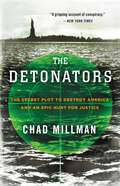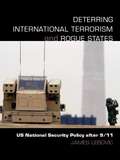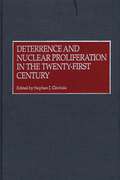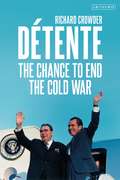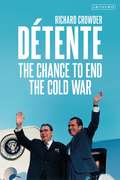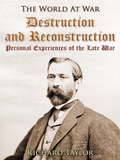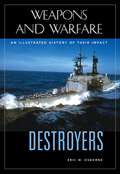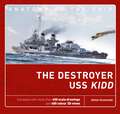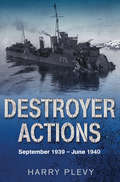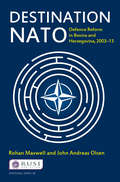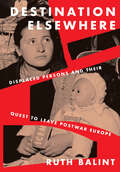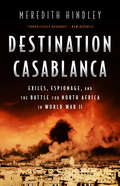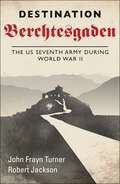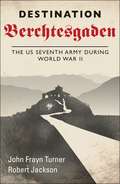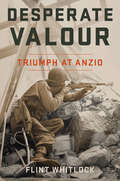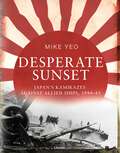- Table View
- List View
Deutsche Exilliteratur 1933-1950: Band 3: Internierung, Flucht und Lebensbedingungen im Zweiten Weltkrieg
by Hans-Albert WalterDie "Geschichte der deutschen Exilliteratur" von Hans-Albert Walter gilt als Meilenstein der Exilliteraturforschung. Im Mittelpunkt von Band 3 steht die Situation der Exilierten in den kriegsführenden Staaten Europas und die Flucht aus Frankreich nach der Niederlage im Juni 1940. Walter schildert den Wettlauf zwischen Leben und Tod und erschließt zugleich eine Fülle bislang nicht berücksichtigter Quellen. Weitere Kapitel gelten der Masseninternierung in Großbritannien, der ausländerfeindlichen Asylpolitik der Schweiz, die durch Grenzsperrungen die Zuflucht aus Frankreich verhinderte, sowie den allgemeinen Lebensbedingungen und der materiellen Situation während des Krieges.
Deutsche Exilliteratur 1933-1950: Band 2: Europäisches Appeasement und überseeische Asylpraxis
by Hans-Albert WalterDie "Geschichte der deutschen Exilliteratur" von Hans-Albert Walter gilt als Meilenstein der Exilliteraturforschung. Band 2 behandelt die politischen und sozialen Lebensbedingungen der Exilierten von der Annexion Österreichs durch Hitlerdeutschland im März 1938 bis zum Eintritt der USA in den Zweiten Weltkrieg im Dezember 1941. Die Folgen der Appeasement-Politik ließen schlagartig die Überlebensmöglichkeiten der exilierten Schriftsteller schrumpfen, dies umso mehr, als zugleich die noch verbliebenen europäischen Fluchtstaaten der einsetzenden neuen Fluchtbewegung mit verschärften Restriktionen und einer gesteigerten Fremdenfeindlichkeit begegneten. In der Sowjetunion vollzog sich im gleichen Zeitraum im Gefolge der stalinistischen Säuberungen und Prozesse die physische Vernichtung eines großen Teils der deutschen Emigranten.
Deutsche Exilliteratur 1933-1950: Band 4: Exilpresse
by Hans-Albert WalterDie "Geschichte der deutschen Exilliteratur" von Hans-Albert Walter gilt als Meilenstein der Exilliteraturforschung. Band 4 widmet sich ausschließlich der Exilpresse. Der Presse kam innerhalb der deutschen Emigration eine besondere Bedeutung zu. Sie war das Sprachrohr der in zahlreiche politische und literarische Gruppierungen zersplitterten Emigration. Zugleich dokumentiert die große Zahl der publizistischen Organe - weit über 400 Publikationen sind bezeugt - und ihre Vielfalt die räumliche Zerstreuung der Emigration über fast alle Länder der Erde. Auf der Grundlage eines reichhaltigen, oft erstmals ausgewerteten Quellen- und Archivmaterials.Literatur- und Kulturgeschichte
The Detonators: The Secret Plot to Destroy America and an Epic Hunt for Justice
by Chad MillmanOne hundred years ago, in July 1916, an act of terrorism in New York Harbor changed the world. The attack in New York Harbor was so explosive that people as far away as Maryland felt the ground shake. Windows were blown out uptown at the New York Public Library; the main building at Ellis Island was nearly destroyed; Statue of Liberty was torn into by shrapnel from the explosion, which would have measured 5.5 on the Richter scale. Chaos overtook Manhattan as the midnight sky turned to fire, lit up with exploding ammunition. The year was 1916. And it had been shockingly easy. While war raged in Europe, Americans watched from afar, unthreatened by the danger overseas. Yet the United States was riddled with networks of German spies hiding in plain sight. The attack on New York Harbor was only one part of their plans: secret anthrax facilities were located just ten miles from the White House; bombs were planted on ships, hidden in buildings, and mailed to the country's civic and business leaders; and an underground syndicate helped potential terrorists obtain fake IDs, housing, and money. President Woodrow Wilson knew an attack of this magnitude was possible, and yet nothing was done to stop it. Americans, feeling buffered by miles of ocean and burgeoning prosperity, had ignored the mounting threat. That all changed on a warm summer evening in late July, when the island in New York Harbor called Black Tom exploded, setting alight a vast store of munitions destined for the front.Three American lawyers -- John McCloy, Amos Peaslee, and Harold Martin -- made it their mission to solve the Black Tom mystery. Their hunt for justice would take them undercover to Europe, deep into the shadowy world of secret agents and double-crosses, through the halls of Washington and the capitals of Europe. It would challenge their beliefs in right and wrong. And they would discover a sinister plot so vast it could hardly have been imagined -- a conspiracy that stretched from downtown Manhattan to the very heart of Berlin. The Detonators is the first full accounting of a crime and a cover-up that resonate strongly in a post-9/11 America. And much of the atmosphere and rhetoric in play 100 years ago remains eerily similar to discussions surrounding national security and immigration today. As Millman deftly illustrates in The Detonators, an island may have disappeared, but the resulting lessons have only grown stronger and more urgent, and history has a persistent way of stirring up its ghosts. This is their story. "A gripping account of conspiracy." -- New York Times "A ready-made suspense thriller." -- Boston Globe "Exhaustively researched... fascinating." -- Entertainment Weekly, 50 Hot Summer Books
Deterring International Terrorism and Rogue States: US National Security Policy after 9/11 (Contemporary Security Studies)
by James H. LebovicThis new study challenges the widely held view that many current US adversaries cannot be deterred, maintaining that deterrence is not a relic of the Cold War period and that it should shape US policies toward so-called ‘rogue states’ and terror groups. James Lebovic argues that deterrence principles continue to apply, and focuses upon the ‘three pillars’ of the Bush administration’s national security policy: missile defence, which preoccupied the administration until September 11, 2001 pre-emption, which became the US focus with the September 11 attacks and US success in overthrowing the Taliban regime in Afghanistan homeland security, which the administration has portrayed as more a natural response to threat than an aspect of policy that must be reconciled with the other pillars. Deterring International Terrorism and Rogue States asserts that bad offences and defences have been endemic to the current US policy approach, leading US policy makers to pursue policies that require them to do everything without adequate concern for resource trade-offs, overreach, and unintended consequences. This book will be of great interest to students of US foreign policy, national and international security, terrorism and international relations in general.
Deterring International Terrorism and Rogue States: US National Security Policy after 9/11 (Contemporary Security Studies)
by James H. LebovicThis new study challenges the widely held view that many current US adversaries cannot be deterred, maintaining that deterrence is not a relic of the Cold War period and that it should shape US policies toward so-called ‘rogue states’ and terror groups. James Lebovic argues that deterrence principles continue to apply, and focuses upon the ‘three pillars’ of the Bush administration’s national security policy: missile defence, which preoccupied the administration until September 11, 2001 pre-emption, which became the US focus with the September 11 attacks and US success in overthrowing the Taliban regime in Afghanistan homeland security, which the administration has portrayed as more a natural response to threat than an aspect of policy that must be reconciled with the other pillars. Deterring International Terrorism and Rogue States asserts that bad offences and defences have been endemic to the current US policy approach, leading US policy makers to pursue policies that require them to do everything without adequate concern for resource trade-offs, overreach, and unintended consequences. This book will be of great interest to students of US foreign policy, national and international security, terrorism and international relations in general.
Deterrence in the Twenty-first Century
by Max G. ManwaringThis anthology argues that facing the diverse threats in the 'new world disorder' requires a new look and new approaches. The requirement is to establish that contemporary deterrence demands replacing the old 'nuclear theology' with new policy and strategy to deal with the myriad state, non-state, and trans-national nuclear and non-nuclear menaces that have heretofore been ignored or wished away.
Deterrence in the Twenty-first Century
by Max G. ManwaringThis anthology argues that facing the diverse threats in the 'new world disorder' requires a new look and new approaches. The requirement is to establish that contemporary deterrence demands replacing the old 'nuclear theology' with new policy and strategy to deal with the myriad state, non-state, and trans-national nuclear and non-nuclear menaces that have heretofore been ignored or wished away.
Deterrence and Nuclear Proliferation in the Twenty-First Century (Non-ser.)
by Stephen J. CimbalaThis edited collection considers the future of nuclear weapons in world politics in terms of security issues that are important for U.S. and other policy makers. The spread of nuclear weapons also is related to the equally dangerous proliferation of other weapons of mass destruction, including chemical and biological weapons, and of ballistic missiles of medium and longer ranges.Cold War studies of nuclear weapons emphasized the U.S.-Soviet relationship, deterrence, and bilateral arms control. A less structured post-Cold War world will require more nuanced appreciation of the diversity of roles that nuclear weapons might play in the hands of new nuclear states or non-state actors. As the essays suggest as well, the possibility of terrorism by means of nuclear or other weapons of mass destruction introduces other uncertainties into military and policy planning. An important analysis for scholars, students, and researchers involved with defense, security, and foreign policy studies.
Détente: The Chance to End the Cold War
by Richard CrowderBetween 1968 and 1975, there was a subtle thawing of relations between East and West, for which Brezhnev coined the name Détente, and – perhaps – a chance to end the Cold War. The leaders of the United States and the Soviet Union, Richard Nixon and Leonid Brezhnev, hoped to forge a new relationship between East and West. Yet, the greatest changes of the era took place outside the sphere of international diplomacy. The 1960s brought social collision across the world, from the anti-war protests in America to the student demonstrations on the streets of Paris, and Mao Tsetung's Red Guards in China. A new generation, whom advertising executives dubbed the baby-boomers, brought new attitudes to towards sex, gender, race, the environment and religion. In this book, Richard Crowder explores the years of Détente, and introduces us to the key players of the era, whose stories form the narrative of this book.
Détente: The Chance to End the Cold War
by Richard CrowderBetween 1968 and 1975, there was a subtle thawing of relations between East and West, for which Brezhnev coined the name Détente, and – perhaps – a chance to end the Cold War. The leaders of the United States and the Soviet Union, Richard Nixon and Leonid Brezhnev, hoped to forge a new relationship between East and West. Yet, the greatest changes of the era took place outside the sphere of international diplomacy. The 1960s brought social collision across the world, from the anti-war protests in America to the student demonstrations on the streets of Paris, and Mao Tsetung's Red Guards in China. A new generation, whom advertising executives dubbed the baby-boomers, brought new attitudes to towards sex, gender, race, the environment and religion. In this book, Richard Crowder explores the years of Détente, and introduces us to the key players of the era, whose stories form the narrative of this book.
Destruction and Reconstruction: Personal Experiences Of The Late War (The World At War)
by Richard TaylorIn this unique series, the Civil War comes vividly to life, as those who were there give eye-witness accounts from both sides of the bloody conflict. A sugar farmer and gentleman politician with no military training before the war, General Richard Taylor--son of President Zachary Taylor--plays a major role in the Red River campaign. Out of print since 1879. (Excerpt from Goodreads)
Destroyers: An Illustrated History of Their Impact (Weapons and Warfare)
by Eric W. OsborneOn July 4, 1991, the Arleigh Burke class of destroyers, the most powerful surface combatants in naval history, was commissioned. It was the culmination of a century-and-a-half evolution of the destroyer—an evolution captured in this vivid and timely history of the world's most popular warship.Destroyers: An Illustrated History of Their Impact tells the story of one of the most-recent, most-rapidly evolving additions to the world's navies. Coverage ranges from the 1882 launch of the first destroyer, through the nonstop technical and strategic innovations of the world war eras, to the current high watermarks of destroyer design such as the Arleigh Burke class (named for the navy's most-famous destroyer squadron combat commander).With its ship-by-ship analysis, this masterful volume shows how destroyers have continually met the challenge of protecting naval and land operations from ever more dangerous attacks. The book also captures the flavor of shipboard life for officers and crew and looks at the crucial role of the destroyer as a standard-bearing status symbol of naval might and political intention.
The Destroyer USS Kidd (Anatomy of The Ship)
by Stefan DraminskiA brilliantly detailed visual representation of the only US World War II destroyer to have retained its original configuration.Superbly illustrated with artwork of the ship through its career, reconstructions of deck layouts, and 3D illustrations of every detail of the ship from its rigging to its boats to its anchors, this book reconstructs and dissects the Fletcher-class destroyer USS Kidd, the most original survivor of the US Navy's most famous class of World War II destroyers. Kidd fought throughout the Pacific War, in the Marshall Islands, Marianas, and Philippines campaigns. In early 1945, Kidd joined Task Force 58 for the invasion of Okinawa, and postwar served in the Korean War. Since 1982 USS Kidd has been a museum ship at Baton Rouge, Louisiana.Drawing on Stefan Draminski's new research and making the best use yet of his acclaimed 3D illustration techniques, this is the most comprehensive examination of USS Kidd ever published. It includes a complete set of detailed line drawings with fully descriptive keys and full-color 3D artwork, supported by technical details, photographs, and a concise history of the ship's construction and service.
Destroyer Actions: September 1939 - June 1940
by Harry PlevyUsing eye-witness accounts of those who participated, Destroyer Actions focuses on the human side of naval operations during the first eight months of the Second World War. Lucid treatment of the political, strategic and tactical background to naval operations allows the reader to understand the pivotal role played by the destroyer during the so called ‘Phoney War’ period.
Destination Normandy: Three American Regiments on D-Day (Studies in Military History and International Affairs)
by G. H. BennettBennett collects oral histories from men of three United States regiments that participated in the invasion of Normandy on June 6, 1944. The 507th Parachute Infantry Regiment was the most widely scattered of the American parachute infantry regiments to be dropped on D-Day. However, the efforts of 180 men to stop the advance of an SS Panzer Grenadier division largely have been ignored outside of France. The 116th Infantry Regiment received the highest number of casualties on Omaha Beach of any Allied unit on D-Day. Stationed in England through most of the war, it had been the butt of jokes while other regiments did the fighting and dying in North Africa and the Mediterranean; that changed on June 6, 1944. And the 22nd Infantry Regiment, a unit that had fought in almost every campaign waged by the U.S. Army since 1812, came ashore on Utah Beach quite easily before getting embroiled in a series of savage fights to cross the marshland behind the beach and to capture the German heavy batteries to the north.Each participant's story is woven into the larger picture of the assault, allowing Bennett to go beyond the largely personal viewpoints yielded by traditional oral history but avoiding the impersonal nature of studies of grand strategy. In addition to the interviews and memoirs Bennett collected, he also discovered fresh documentary evidence from American, British, and French archives that play an important part in facilitating this new approach, as well as archives in Britain and France. The author unearths new stories and questions from D-Day, such as the massacre of soldiers from the 507th at Graignes, Hemevez, and elsewhere. This new material includes a focus on the regimental level, which is all but ignored by historians, while still covering strategic, tactical, and human issues. His conclusions highlight common misperceptions about the Normandy landings. Questions have already been raised about the wisdom of the Anglo-American amphibious doctrine employed on D-Day. In this study, Bennett continues to challenge the assumption that the operation was an exemplary demonstration of strategic planning.
Destination NATO: Defence Reform in Bosnia and Herzegovina, 2003–13 (Whitehall Papers)
by Rohan Maxwell John Andreas OlsenDefence reform has been a major component of Bosnia’s stabilisation and nation-building. Though true for many cases of post-conflict transition, it is especially so for Bosnia, which arguably has the most complex state structure in Europe. Ten years on from the start of Bosnia’s defence-reform process, Destination NATO records and reviews the Bosnian experience of defence reform. The monograph offers policy-makers, practitioners and academics knowledge of the specific case of Bosnia and Herzegovina, and makes these insights relevant to defence-reform efforts in other contexts. The research is based on original sources and an extensive set of interviews and talks with key individuals including ambassadors, ministers and civil servants, and other senior national and international actors, in addition to discussions with several hundred politicians at local levels, students and NGO representatives. The authors also use their first-hand knowledge and insights to complement the documentation, interviews and discussions.
Destination NATO: Defence Reform in Bosnia and Herzegovina, 2003–13 (Whitehall Papers)
by Rohan Maxwell John Andreas OlsenDefence reform has been a major component of Bosnia’s stabilisation and nation-building. Though true for many cases of post-conflict transition, it is especially so for Bosnia, which arguably has the most complex state structure in Europe. Ten years on from the start of Bosnia’s defence-reform process, Destination NATO records and reviews the Bosnian experience of defence reform. The monograph offers policy-makers, practitioners and academics knowledge of the specific case of Bosnia and Herzegovina, and makes these insights relevant to defence-reform efforts in other contexts. The research is based on original sources and an extensive set of interviews and talks with key individuals including ambassadors, ministers and civil servants, and other senior national and international actors, in addition to discussions with several hundred politicians at local levels, students and NGO representatives. The authors also use their first-hand knowledge and insights to complement the documentation, interviews and discussions.
Destination Elsewhere: Displaced Persons and Their Quest to Leave Postwar Europe
by Ruth BalintIn this unique "history from below," Destination Elsewhere chronicles encounters between displaced persons in Europe and the Allied agencies who were tasked with caring for them after the Second World War. The struggle to define who was a displaced person and who was not was a subject of intense debate and deliberation among humanitarians, international law experts, immigration planners, and governments. What has not adequately been recognized is that displaced persons also actively participated in this emerging refugee conversation. Displaced persons endured war, displacement, and resettlement, but these experiences were not defined by passivity and speechlessness. Instead, they spoke back, creating a dialogue that in turn helped shape the modern idea of the refugee. As Ruth Balint shows, what made a good or convincing story at the time tells us much about the circulation of ideas about the war, the Holocaust, and the Jews. Those stories depict the emerging moral and legal distinction between economic migrants and political refugees. They tell us about the experiences of women and children in the face of new psychological and political interventions into the family. Stories from displaced persons also tell us something about the enduring myth of the new world for people who longed to leave the old. Balint focuses on those persons whose storytelling skills became a major strategy for survival and escape out of the displaced persons' camps and out of the Europe. Their stories are brought to life in Destination Elsewhere, alongside a new history of immigration, statelessness, and the institution of the postwar family.
Destination Casablanca: Exile, Espionage, and the Battle for North Africa in World War II
by Meredith HindleyThis rollicking and panoramic history of Casablanca during the Second World War sheds light on the city as a key hub for European and American powers, and a place where spies, soldiers, and political agents exchanged secrets and vied for control. In November 1942, as a part of Operation Torch, 33,000 American soldiers sailed undetected across the Atlantic and stormed the beaches of French Morocco. Seventy-four hours later, the Americans controlled the country and one of the most valuable wartime ports: Casablanca.In the years preceding, Casablanca had evolved from an exotic travel destination to a key military target after France's surrender to Germany. Jewish refugees from Europe poured in, hoping to obtain visas and passage to the United States and beyond. Nazi agents and collaborators infiltrated the city in search of power and loyalty. The resistance was not far behind, as shopkeepers, celebrities, former French Foreign Legionnaires, and disgruntled bureaucrats formed a network of Allied spies. But once in American hands, Casablanca became a crucial logistical hub in the fight against Germany--and the site of Roosevelt and Churchill's demand for "unconditional surrender."Rife with rogue soldiers, power grabs, and diplomatic intrigue, Destination Casablanca is the riveting and untold story of this glamorous city--memorialized in the classic film that was rush-released in 1942 to capitalize on the drama that was unfolding in North Africa at the heart of World War II.
Destination Casablanca: Exile, Espionage, and the Battle for North Africa in World War II
by Meredith HindleyThis rollicking and panoramic history of Casablanca during the Second World War sheds light on the city as a key hub for European and American powers, and a place where spies, soldiers, and political agents exchanged secrets and vied for control. In November 1942, as a part of Operation Torch, 33,000 American soldiers sailed undetected across the Atlantic and stormed the beaches of French Morocco. Seventy-four hours later, the Americans controlled the country and one of the most valuable wartime ports: Casablanca. In the years preceding, Casablanca had evolved from an exotic travel destination to a key military target after France's surrender to Germany. Jewish refugees from Europe poured in, hoping to obtain visas and passage to the United States and beyond. Nazi agents and collaborators infiltrated the city in search of power and loyalty. The resistance was not far behind, as shopkeepers, celebrities, former French Foreign Legionnaires, and disgruntled bureaucrats formed a network of Allied spies. But once in American hands, Casablanca became a crucial logistical hub in the fight against Germany -- and the site of Roosevelt and Churchill's demand for "unconditional surrender." Rife with rogue soldiers, power grabs, and diplomatic intrigue, Destination Casablanca is the riveting and untold story of this glamorous city--memorialized in the classic film that was rush-released in 1942 to capitalize on the drama that was unfolding in North Africa at the heart of World War II.
Destination Berchtesgaden: The US Seventh Army during World War II (Osprey Digital Generals Ser.)
by John Frayn Turner Robert JacksonOf the US Armies fighting in Europe at the end of World War II, General Patch's Seventh Army has received the least attention from historians. Although over-shadowed by the performance of General Patton and the actions of his US Third Army (breaking out of the Normandy bridgehead, liberating Paris and seizing Remagen bridge), the Seventh Army made a considerable contribution to the Allied victory, particularly their rapid advance through southern Germany and Austria. The Seventh Army landed in Sicily in 1943, and then took part in Operation Anvil in 1944 before advancing across the Rhine and reaching Berchtesgaden itself. Both the successes and setbacks of the Seventh Army are discussed in this volume, as well as discussing the tactical victories and defeats that contributed to the Allied campaign.
Destination Berchtesgaden: The US Seventh Army during World War II
by John Frayn Turner Robert JacksonOf the US Armies fighting in Europe at the end of World War II, General Patch's Seventh Army has received the least attention from historians. Although over-shadowed by the performance of General Patton and the actions of his US Third Army (breaking out of the Normandy bridgehead, liberating Paris and seizing Remagen bridge), the Seventh Army made a considerable contribution to the Allied victory, particularly their rapid advance through southern Germany and Austria. The Seventh Army landed in Sicily in 1943, and then took part in Operation Anvil in 1944 before advancing across the Rhine and reaching Berchtesgaden itself. Both the successes and setbacks of the Seventh Army are discussed in this volume, as well as discussing the tactical victories and defeats that contributed to the Allied campaign.
Desperate Valour: Triumph at Anzio
by Flint WhitlockA riveting and comprehensive account of the Battle of Anzio and the Alamo-like stand of American and British troops that turned certain defeat into victory The four-month-long 1944 battle on Italy's coast, south of Rome, was one of World War II's longest and bloodiest battles. Surrounded by Nazi Germany's most fanatical troops, American and British amphibious forces endured relentless mortar and artillery barrages, aerial bombardments, and human-wave attacks by infantry with panzers. Through it all, despite tremendous casualties, the Yanks and Tommies stood side by side, fighting with, as Winston Churchill said, "desperate valour." So intense and heroic was the fighting that British soldiers were awarded two Victoria Crosses, while American soldiers received twenty-six Medals of Honor--ten of them awarded posthumously. The unprecedented defensive stand ended with the Allies breaking out of their besieged beachhead and finally reaching their goal: Rome. They had truly snatched victory from the jaws of defeat. Award-winning author and military historian Flint Whitlock uses official records, memoirs, diaries, letters, and interviews with participants to capture the desperate nature of the fighting and create a comprehensive account of the unrelenting slugfest at Anzio.Desperate Valour is a stirring chronicle of courage beyond measure.
Desperate Sunset: Japan’s kamikazes against Allied ships, 1944–45
by Mike YeoBy the middle of 1944, Imperial Japan's armed forces were in an increasingly desperate situation. Its elite air corps had been wiped out over the Solomons in 1942–43, and its navy was a shadow of the force that had attacked Pearl Harbor in 1941. But the Japanese had one last, desperate, card to play. The Japanese High Command decided that the way to inflict maximum damage on the superior enemy forces was to get the poorly trained Japanese pilots to crash their explosive-laden aircraft onto their target, essentially turning themselves into a guided missile. The kamikazes announced themselves in the immediate aftermath of the Leyte Gulf naval battles, sinking the USS St. Lo and damaging several other ships. The zenith of the kamikaze came in the battle of Okinawa, which included ten kikusui (Floating Chrysanthemum) operations which involved up to several hundred aircraft attacking the US fleet.Fully illustrated throughout, Desperate Sunset examines the development and evolution of the kamikaze using first-hand accounts, combat reports and archived histories.



